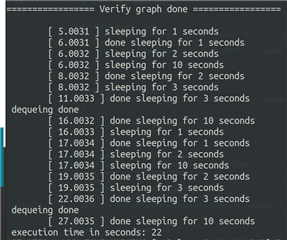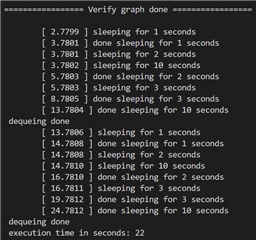Tool/software:
Hi Nikhil Dasan,
I am experimenting with a custom graph pipeline that contains 4 nodes, schematic diagram is shown.

Here, circles represent nodes and squares represent data reference queues. D1 and D4 are Graph parameters. Others are intermediate data reference queues. The function of the nodes is as follows: Nodes N1, N2 and N3 sleep for 1 sec, 2 sec, 3 sec respectively. Node N4 sleeps for 10 sec. So by the time node N3 has finished execution, node N4 will be sleeping further for 5 seconds. Since the data reference queue D4 is a graph parameter, it will send the reference consumed command to the host once N3 has completed execution, which will signal the event that waits to dequeue the reference from the graph parameter D4.
In my case, even though the reference consumed command is sent from the target side, the reference is not being consumed by the host till node N4 has completed its execution. Can you guide me what could cause this delay in the above case?
The code for the same is attached below.
#include <stdio.h>
#include <unistd.h>
#include <VX/vx.h>
#include <VX/vx_khr_pipelining.h>
#include <TI/tivx.h>
#include <utility.h>
#include <tivx_openvx_core_kernels.h>
#define IN0_IMG_IDX (0u)
#define SLEEP_PARAM_IDX (1u)
#define OUT0_IMG_IDX (2u)
#define MAX_PARAMS (3u)
#define BUF_SIZE (2u)
static vx_enum kernel_id = (vx_status)VX_ERROR_INVALID_PARAMETERS;
static vx_kernel g_kernel = NULL;
static vx_status VX_CALLBACK kernel_init(vx_node node, vx_reference parameters[], vx_int32 num){
// printf(" vx_custom_node_1: init SUCCESS ... \n");
return VX_SUCCESS;
}
static vx_status VX_CALLBACK kernel_run(vx_node node, vx_reference parameters[], vx_uint32 num){
// vx_image in_image = (vx_image)parameters[IN0_IMG_IDX];
// vx_image out_image = (vx_image)parameters[OUT0_IMG_IDX];
vx_scalar sleep_time = (vx_scalar)parameters[SLEEP_PARAM_IDX];
int t;
vxCopyScalar(sleep_time, &t, VX_READ_ONLY, VX_MEMORY_TYPE_HOST);
printf(" \t[ %3.4f ] sleeping for %d seconds \n", tivxPlatformGetTimeInUsecs()/1000000.0, t);
sleep(t);
printf(" \t[ %3.4f ] done sleeping for %d seconds \n", tivxPlatformGetTimeInUsecs()/1000000.0, t);
return VX_SUCCESS;
}
static vx_status VX_CALLBACK kernel_deinit(vx_node node, vx_reference parameters[], vx_uint32 num){
return VX_SUCCESS;
}
static vx_status VX_CALLBACK kernel_validate(vx_node node,
const vx_reference parameters[ ],
vx_uint32 num, vx_meta_format metas[]){
return VX_SUCCESS;
}
static vx_node get_kernel_node(vx_graph graph, vx_image in, vx_scalar sleep_time, vx_image out){
vx_node node;
vx_reference refs[] = {(vx_reference)in, (vx_reference)sleep_time, (vx_reference)out};
node = tivxCreateNodeByKernelEnum(graph,kernel_id,refs,3);
vxSetReferenceName((vx_reference)node, "NODE");
return node;
}
static vx_status kernel_create(vx_context context){
vx_kernel kernel = NULL;
vx_status status;
int index=0;
status = vxAllocateUserKernelId(context, &kernel_id);
kernel = vxAddUserKernel(
context,
"kernel_1",
kernel_id,
kernel_run,
3,
kernel_validate,
kernel_init,
kernel_deinit
);
tivxKernelsHostUtilsAddKernelTargetDsp(kernel);
tivxAddKernelTarget(kernel, TIVX_TARGET_MPU_3);
// tivxAddKernelTarget(kernel, TIVX_TARGET_DSP1);
// #ifndef SOC_AM62A
// tivxAddKernelTarget(kernel, TIVX_TARGET_DSP2);
// #endif
// tivxAddKernelTarget(kernel, TIVX_CPU_ID_MPU_0);
status = vxGetStatus((vx_reference)kernel);
if(status==VX_SUCCESS){
status = vxAddParameterToKernel(
kernel,
index++,
(vx_enum)VX_INPUT,
(vx_enum)VX_TYPE_IMAGE,
(vx_enum)VX_PARAMETER_STATE_REQUIRED
);
}
printf(" done adding input image parameter \n");
if(status==VX_SUCCESS){
status = vxAddParameterToKernel(
kernel,
index++,
(vx_enum)VX_INPUT,
(vx_enum)VX_TYPE_SCALAR,
(vx_enum)VX_PARAMETER_STATE_REQUIRED
);
}
printf(" done adding input int parameter \n");
if(status==VX_SUCCESS){
status = vxAddParameterToKernel(
kernel,
index++,
(vx_enum)VX_OUTPUT,
(vx_enum)VX_TYPE_IMAGE,
(vx_enum)VX_PARAMETER_STATE_REQUIRED
);
}
printf(" done adding output image parameter \n");
if(status == VX_SUCCESS){
status = vxFinalizeKernel(kernel);
}
if(status != VX_SUCCESS){
vxReleaseKernel(&kernel);
kernel = NULL;
}else{
g_kernel = kernel;
}
}
static vx_status kernel_remove(vx_context context){
vx_status status;
status = vxRemoveKernel(g_kernel);
g_kernel = NULL;
return status;
}
static void add_graph_parameter_by_node_index(vx_graph graph, vx_node node, vx_uint32 node_parameter_index)
{
vx_parameter parameter = vxGetParameterByIndex(node, node_parameter_index);
vxAddParameterToGraph(graph, parameter);
vxReleaseParameter(¶meter);
}
void vx_custom_pipeline_split_data_q(){
vx_context context;
vx_graph graph;
vx_image img1[BUF_SIZE], img2, img3, img4[BUF_SIZE], img5;
vx_node node_1, node_2, node_3, node_4;
vx_uint32 width=640, height=480;
vx_status status;
vx_uint32 num_buf=BUF_SIZE, pipeline_depth=2, buf_id, loop_id, loop_cnt=2, exe_time;
vx_graph_parameter_queue_params_t graph_params_list[2];
printf(" Tutorial started !!! \n");
context = vxCreateContext();
status = kernel_create(context);
printf(" done creating kernel, kernel_id = %d \n", kernel_id);
for(int i=0;i<num_buf;i++){
img1[i] = vxCreateImage(context, width, height, (vx_df_image)VX_DF_IMAGE_U8);
img4[i] = vxCreateImage(context, width, height, (vx_df_image)VX_DF_IMAGE_U8);
}
img2 = vxCreateImage(context, width, height, (vx_df_image)VX_DF_IMAGE_U8);
img3 = vxCreateImage(context, width, height, (vx_df_image)VX_DF_IMAGE_U8);
img5 = vxCreateImage(context, width, height, (vx_df_image)VX_DF_IMAGE_U8);
printf(" done initializing image variables \n");
graph = vxCreateGraph(context);
vx_int32 tmp = 1;
vx_scalar sleep_time_1 = vxCreateScalar(context, VX_TYPE_INT32, &tmp);
tmp = 2;
vx_scalar sleep_time_2 = vxCreateScalar(context, VX_TYPE_INT32, &tmp);
tmp = 3;
vx_scalar sleep_time_3 = vxCreateScalar(context, VX_TYPE_INT32, &tmp);
tmp = 10;
vx_scalar sleep_time_4 = vxCreateScalar(context, VX_TYPE_INT32, &tmp);
node_1 = get_kernel_node(graph, img1[0], sleep_time_1, img2);
node_2 = get_kernel_node(graph, img2, sleep_time_2, img3);
node_3 = get_kernel_node(graph, img3, sleep_time_3, img4[0]);
node_4 = get_kernel_node(graph, img2, sleep_time_4, img5);
printf(" node creation done \n");
vxSetNodeTarget(node_1, (vx_enum)VX_TARGET_STRING, TIVX_TARGET_MPU_3);
vxSetNodeTarget(node_2, (vx_enum)VX_TARGET_STRING, TIVX_TARGET_MPU_3);
vxSetNodeTarget(node_3, (vx_enum)VX_TARGET_STRING, TIVX_TARGET_MPU_3);
vxSetNodeTarget(node_4, (vx_enum)VX_TARGET_STRING, TIVX_TARGET_DSP_C7_1);
// TIVX_TARGET_DSP_C7_1
add_graph_parameter_by_node_index(graph, node_1, 0);
add_graph_parameter_by_node_index(graph, node_3, 2);
graph_params_list[0].graph_parameter_index = 0;
graph_params_list[0].refs_list_size = num_buf;
graph_params_list[0].refs_list = (vx_reference *)&img1[0];
graph_params_list[1].graph_parameter_index = 1;
graph_params_list[1].refs_list_size = num_buf;
graph_params_list[1].refs_list = (vx_reference *)&img4[0];
vxSetGraphScheduleConfig(
graph,
(vx_enum)VX_GRAPH_SCHEDULE_MODE_QUEUE_AUTO,
2,
graph_params_list
);
tivxSetGraphPipelineDepth(graph, pipeline_depth);
tivxSetNodeParameterNumBufByIndex(node_1, 2, 1);
tivxSetNodeParameterNumBufByIndex(node_2, 2, num_buf);
tivxSetNodeParameterNumBufByIndex(node_4, 2, num_buf);
status = vxVerifyGraph(graph);
printf("\n================= Verify graph done =================\n\n");
exe_time = tivxPlatformGetTimeInUsecs();
vx_image cur_out_img, cur_in_img;
uint32_t num_refs;
/* Running the loop */
for(buf_id=0;buf_id<BUF_SIZE;buf_id++){
vxGraphParameterEnqueueReadyRef(graph, 0, (vx_reference *)&img1[buf_id], 1);
vxGraphParameterEnqueueReadyRef(graph, 1, (vx_reference *)&img4[buf_id], 1);
}
for(loop_id=0;loop_id<loop_cnt;loop_id++){
vx_image cur_out_img=img4[0], cur_in_img=img1[0];
uint32_t num_refs;
vxGraphParameterDequeueDoneRef(graph, 0, (vx_reference *)&cur_in_img, 1, &num_refs);
vxGraphParameterDequeueDoneRef(graph, 1, (vx_reference *)&cur_out_img, 1, &num_refs);
// printf(" dequeing done \n");
// Use the output
if(loop_id>=loop_cnt-num_buf)continue;
vxGraphParameterEnqueueReadyRef(graph, 0, (vx_reference *)&cur_in_img, 1);
vxGraphParameterEnqueueReadyRef(graph, 1, (vx_reference *)&cur_out_img, 1);
}
vxWaitGraph(graph);
exe_time = tivxPlatformGetTimeInUsecs() - exe_time;
printf(" execution time in seconds: %d \n", exe_time/1000000);
for(int i=0;i<num_buf;i++){
vxReleaseImage(&img1[i]);
vxReleaseImage(&img4[i]);
}
vxReleaseImage(&img2);
vxReleaseImage(&img3);
vxReleaseScalar(&sleep_time_1);
vxReleaseScalar(&sleep_time_2);
vxReleaseScalar(&sleep_time_3);
vxReleaseNode(&node_1);
vxReleaseNode(&node_2);
vxReleaseNode(&node_3);
vxReleaseGraph(&graph);
kernel_remove(context);
vxReleaseContext(&context);
printf(" Tutorial completed !!! \n");
}
FYI, I am running the above code in host emulation mode. Additionally, I got to know about the exact time stamps when the reference is released and consumed with the help of logs in the respective function calls.
Kindly explain me the scenario what is happening internally. Thanks in advance!



